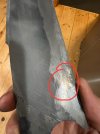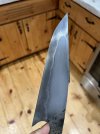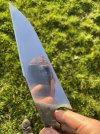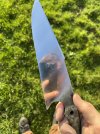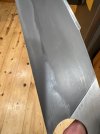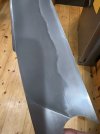- Joined
- Dec 28, 2022
- Messages
- 104
Did my first Hamon today on 1075 steel and I am very happy with the results. It’s tempered and I’ve done some post heat treat grinding up to 400 grit and did a quick dip in ferric chloride to see what the Hamon looked like. I noticed some longitudinal striations on the blade that run opposite of the direction belt scratches would be going. I have hand sanded the other side of the knife a bit to get deep scratches out and I’m still seeing these longitudinal lines. Does anyone have any idea what here are from? I have never had them on any of my knives before. thanks for any help!
Mason Ostrom
Mason Ostrom

